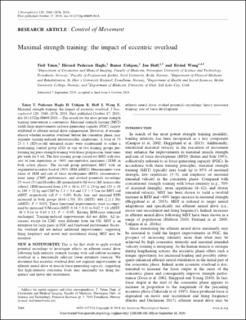| dc.description.abstract | The search for the most potent strength training intervention is continuous. Maximal strength training (MST) yields large improvements in force-generating capacity (FGC), largely attributed to efferent neural drive enhancement. However, it remains elusive whether eccentric overload, before the concentric phase, may augment training-induced neuromuscular adaptations. A total of 53 23 ± 3 (SD)-yr-old untrained males were randomized to either a nontraining control group (CG) or one of two training groups performing leg press strength training with linear progression, three times per week for 8 wk. The first training group carried out MST with four sets of four repetitions at ~90% one-repetition maximum (1RM) in both action phases. The second group performed MST with an augmented eccentric load of 150% 1RM (eMST). Measurements were taken of 1RM and rate of force development (RFD), countermovement jump (CMJ) performance, and evoked potentials recordings [V-wave (V) and H-reflex (H) normalized to M-wave (M) in musculus soleus]. 1RM increased from 133 ± 16 to 157 ± 23 kg and 123 ± 18 to 149 ± 22 kg and CMJ by 2.3 ± 3.6 and 2.2 ± 3.7cm for MST and eMST, respectively (all P < 0.05). Early, late, and maximal RFD increased in both groups [634–1,501 N/s (MST); 644–2,111 N/s (eMST); P < 0.05]. These functional improvements were accompanied by increased V/M-ratio (MST: 0.34 ± 0.11 to 0.42 ± 14; eMST: .36 ± 0.14 to 0.43 ± 13; P < 0.05). Resting H/M-ratio remained unchanged. Training-induced improvements did not differ. All increases, except for CMJ, were different from the CG. MST is an enterprise for large gains in FGC and functional performance. Eccentric overload did not induce additional improvements, suggesting firing frequency and motor unit recruitment during MST may be maximal. | en_US |

